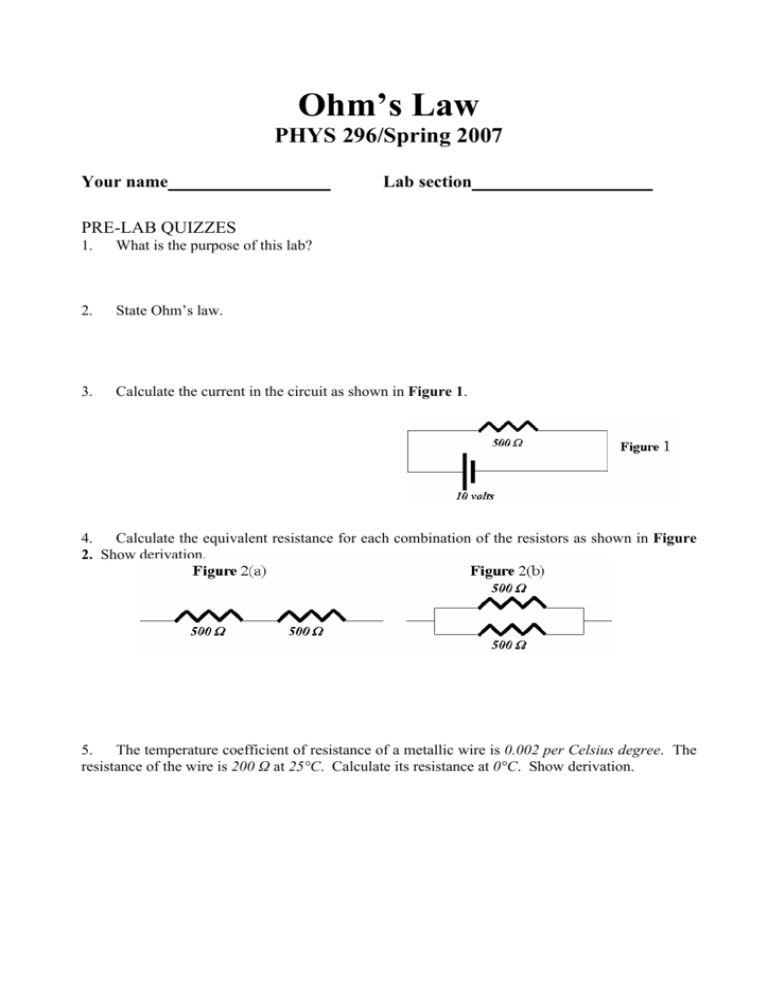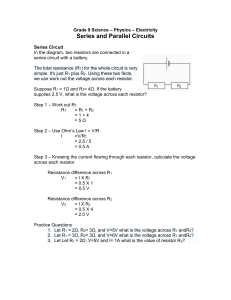Lab V
advertisement

Ohm’s Law PHYS 296/Spring 2007 Your name___________ Lab section_______________ __ PRE-LAB QUIZZES 1. What is the purpose of this lab? 2. State Ohm’s law. 3. Calculate the current in the circuit as shown in Figure 1. 4. Calculate the equivalent resistance for each combination of the resistors as shown in Figure 2. Show derivation. 5. The temperature coefficient of resistance of a metallic wire is 0.002 per Celsius degree. The resistance of the wire is 200 Ω at 25°C. Calculate its resistance at 0°C. Show derivation. Ohm’s Law PHYS 296/Spring 2007 Name_ _________ Lab section_______________ Lab partner’s name(s)_____ __ ______ Purpose In this lab, we demonstrate Ohm’s law using the resistor and study the temperature dependence of the electric resistivity of the copper wire. We also compare the V-versus-I behaviors between the resistor which obeys Ohm’s law and the diode which does not obey Ohm’s law. Background The introduction of electricity in the 19th century and of the solid state electronics in the 20th century to almost every corner of the industry and our daily life is arguably the most important technological advance in history. The electrical and electronic components such as transistors, resistors, capacitors, diodes, etc. are ubiquitous in our life. These components are the building blocks for numerous types of circuits with a vast array of functions. One of these magic products is this computer sitting on your lab bench. In this lab, we will first study the most basic electrical component: resistor. An ideal resistor obeys Ohm’s Law discovered by George Ohm: V/I is a constant, (1) where I (unit: ampere (A) =coulomb per second) is the current running through the resistor and V (unit: volt (V)) is the voltage across the resistor. The ratio V/I is the resistance of the resistor: R (unit: ohm (Ω)). Thus, Ohm’s Law can be stated as: R= V . I (2) Physicists found that all materials possess electricity to various degrees. Some materials resist current very little while others resist current almost completely. In general, the resistance of a material depends on the applied voltage. For many materials this dependence is weak and they can be treated as ideal resistor. In an electrical circuit, a combination of resistors can be connected as in parallel (Figure 3) or in series (Figure 4). The equivalent resistance, R, for the resistors in series is given by R = R1 + R2 + L + Rn . (3) The equivalent resistance, R, for the resistors in parallel is given by 1 1 1 1 = + +L+ . R R1 R2 Rn (4) The table as shown below displays the symbols for several electrical components including resistor, capacitor, inductor, and battery, most commonly found in the electrical circuit. ELECTRICAL COMPONENTS IN CIRCUITS SYMBOL NAME Resistor Capacitor Inductor Voltage Diode You must follow the two following rules to conduct the measurement of current and voltage: (a) CURRENT – ammeter is always connected in series (current meter usually has very small resistance and do not affect the circuit much). (b) VOLTAGE – voltmeter is always connected in parallel (voltmeter usually has very large resistance so the circuit is not affected much). If you do not follow these rules, the readings you take will be incorrect and you may burn out the ammeter. PART I Ohm’s Law In part I of the lab, we demonstrate Ohm’s law using single resistor. Figure 5 PROCEDURES 1. Set up the circuit as shown in Figure 5. Have your TA to check the circuit to ensure that the corrections are correct. 2. Open Data Studio, select input channel A as the voltage sensor to measure the voltage across the resistor and select input Channel B as the current sensor to measure the current through the resistor. Open a graph, select voltage (channel A) for the y-axis, change the default setting of the x-axis from time to the current measured by input Channel B. Label the axes and specify the scales and units. Open the signal generator and select Triangle wave as the output. Set the amplitude at 1 V and the frequency at 25 Hz. 3. Set the sampling rate of both the voltage sensor and the current sensor at 2500 Hz or faster. This is done by clicking the small “+” sign at the bottom of the signal generator window and raising or lowering the sample rate. In so doing, in each period of the Triangle wave, you can collect over 100 data points from the voltage sensor and the current sensor. 4. Click on “start” to record data. Just a few seconds should accumulate enough data points. Data Analysis 1. Choose an appropriate formula from the curve-fitting menu. Use it to fit the acquired Vversus-I curve in the graph window. Write the equation of fitting below. Label the graph appropriately and print it out. 2. Determine the resistance of the resistor by comparing the colors of the rings on the resistor with the color codes on the provided reference card. Compare this resistance to the fitted slope of the V-versus-I curve. Compute the % error of the measurement. PART II Resistors in Series PROCEDURES 1. Remove all the components from the breadboard. Set up the circuit with the three resistors in series. Now, because the current is much smaller, change the sensitivity of the current sensor to “High”. Ask the TA to explain if you do not know how to set up. Ask the TA to check the circuit when you finish setup. 2. Following step 2 to step 4 in Part I. Questions 1. Fit the acquired V-versus-I curve. What is the resistance of the circuit? 2. Calculate the equivalent resistance of the three resistors in series. Show derivation. Find the % error of the measured equivalent resistance compared to the calculated equivalent resistance. PART III Resistors in Parallel PROCEDURES 1. Remove all the components from the breadboard. Set up the circuit with the three resistors in parallel. Ask the TA to explain if you do not know how to set up. Ask the TA to check the circuit when you finish setup. 2. Following step 2 to step 4 in Part I. Questions 1. Fit the acquired V-versus-I curve. What is the resistance of the circuit? 2. Calculate the equivalent resistance of the three resistors in parallel. Show derivation. Find the % error of the measured equivalent resistance compared to the calculated equivalent resistance. 3. Assume that the applied voltage across this circuit is 220 V, what would be the current in the circuit? Show the derivation. PART IV Temperature Dependence of Resistivity In Part IV of the lab, we investigate the temperature dependence of the electric resistivity of the copper wire. In metals, the electric current is carried by the conduction electrons. Coherent transport of the conduction electrons in an applied electric field can be disrupted by random motion of atoms or other electrons, for instance by the random vibration of the atoms about their equilibrium lattice positions. These random motions increase as the temperature (T (unit: °C)) increases. As a result, the resistance of the metal increases with temperature as described by: R( T ) = R0 ( 1 + αT ) . (2) where R(t) is the resistance at temperature of T, R0 is the resistance at 0 °C, and α is a constant called the temperature coefficient of resistance. In this study, the resistance of the spool of copper wire is about 100 Ω. PROCEDURES 1. Ask the TA to fill the tin can with hot water. Place the can cover with the copper wire spool over the can. Treat the copper wire as a resistor and connect it to the circuit through the red-black pair of “banana connector”, as you have done in Part I. In addition, insert the temperature sensor into the center hole of the spool and connect it to Channel C. 2. Open Data Studio, select input channel A as the voltage sensor to measure the voltage across the copper wire, select input Channel B as the current sensor to measure the current through it, and select input Channel C as the temperature sensor (the first of the three temperature sensors) to measure the temperature inside the can. Set the sample rate at 1 Hz for all of them. 3. Open the calculator window and enter the equation R(Ω) = V/I. 4. Double click on Table and Graph display windows. Table will show a column of resistance taken from the calculator icon. In the graph window, select the resistance from the calculator icon for the y-axis, change the default setting of the x-axis from time to the temperature measured by input Channel C. Label the axes and specify the scales and units. 5. Open the signal generator window, select DC output, set voltage at 2 V, and select the auto mode. 6. Start recording data when the hot water has been in the can for about 5 minutes. Stop after over 20 minutes of data collection. Fit the resistance-versus-temperature curve in the graph window and print out the graph. Questions 1. From the fitting equation of the resistance-versus-temperature curve, obtain R0. 2. From the fitting equation, obtain the value of α from the slope of the curve. Compare with the textbook value for copper of α = 4.65 x 10-3 (°C)-1, what is the percent error between the calculated value and the textbook value? PART V Diode In part V of the lab, we demonstrate that the diode does not obey Ohm’s. Figure 8 PROCEDURES 1. Set up the circuit as shown in Figure 8. Have your TA to check the circuit to ensure that the corrections are correct. Open Data Studio, select input channel A as the voltage sensor to measure the voltage across the resistor and select input Channel B as the current sensor to measure the current through the resistor. Open a graph, select the current measured by input Channel B for the y-axis, change the default setting of the x-axis from time to the voltage (channel A). Label the axes and specify the scales and units. 2. Open the signal generator and select Triangle wave as the output. Set the amplitude at 1 V and the frequency at 25 Hz. 3. Set the sampling rate of both the voltage sensor and the current sensor at 2500 Hz or faster. 4. Click on “start” to record the data. Just a few seconds should suffice. Questions 1. Does the diode obey Ohm’s Law? Explain how you draw the conclusion based on the measure I-versus-V curve. 2. When the voltage is negative, what is the value of the current through the diode? What kind of application you can envision for this property of the diode (which we will use in Lab VI)?








